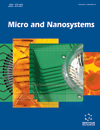- Home
- A-Z Publications
- Micro and Nanosystems
- Previous Issues
- Volume 2, Issue 4, 2010
Micro and Nanosystems - Volume 2, Issue 4, 2010
Volume 2, Issue 4, 2010
-
-
Editorial [Hot Topic: Synergistic Development of Microfluidic Systems and Cellomics (Guest Editor: Giuseppina Simone)]
More LessFor decades, the scientists have been trying to solve the intricate questions of the biology and the human science by reaching successful results. Although many questions are still open and one of the main reasons is the inadequate methods that biologists and biochemists have available. To date a snapshot of the actual scientific world shows a huge gap between biology and technology and a strong difficulty in talking, due to Read More
-
-
-
A Fluidic Motherboard for Multiplexed Simultaneous and Modular Detection in Microfluidic Systems for Biological Application
More LessWe propose a polymer-based microfluidic motherboard that integrates waveguides and fluidic networks providing an interface between microfluidic systems and the outer world. The motherboard facilitates interconnections of several microfluidic chips for multiplexed and simultaneous analysis. It offers a modular network for microfluidic chips, allowing complex microfluidic processes, where each microchip has a particular functi Read More
-
-
-
Transparent Multilevel Aligned Electrode Microfluidic Chip for Dielectrophoretic Colloidal Handling
More LessAuthors: T. Honegger, K. Berton, O. Lecarme, L. Latu-Romain and D. PeyradeSpatial localization and handling of cells and colloid trajectories in a microfluidic channel are required to fully control their interactions at a single level. This paper presents a novel transparent multilevel aligned electrode microfluidic chip that is fast to process and reusable, with which high throughput for dielectrophoretic handling of polarizable particles can be achieved. Performances of the chips are evaluated by electrical Read More
-
-
-
A Transient 3D-CFD Model Incorporating Biological Processes for Use in Tissue Engineering
More LessAuthors: U. Kruhne, D. Wendt, I. Martin, M. V. Juhl, S. Clyens and N. TheilgaardIn this article a mathematical model is presented in which the fluid dynamic interaction between the liquid flow in a scaffold and growing cells is simulated. The model is based on a computational fluid dynamic (CFD) model for the representation of the fluid dynamic conditions in the scaffold. It includes furthermore a simple biological growth model based on Michaelis Menten type kinetics for the growth of cells. The model incl Read More
-
-
-
Ca2+ Mediates the Adhesion of Breast Cancer Cells in Self-Assembled Multifunctional Microfluidic Chip Prepared with Carbohydrate Beads
More LessAuthors: G. Simone and G. PerozzielloCalcium has been demonstrated to have a fundamental role in cell-cell recognition mediating the carbohydrate- carbohydrate and the protein-carbohydrate interactions. A self assembled multifunctional microfluidic array has been used to exploit the interactions between breast tumor cells and an engineered surface. Engineering concerns the topology of the surface, since microbeads have been used to increase the micro r Read More
-
-
-
Growth and Attachment of Embryonic Stem Cell Colonies on Single Nanofibers
More LessColony formation is one of the most important characteristics of the pluripotency of embryonic stem cells (ESC). On a flat surface of soft material such as polydimethylsiloxane (PDMS), the formation efficiency as well as the processing stability of ESC colonies is significantly lower than that on harder material surfaces. To still use PDMS as substrate for cell culture which is interesting for both microdevice fabrication and cell diffe Read More
-
-
-
Development of Patch-Clamp Chips for Mammalian Cell Applications
More LessWe have previously described the designs of two planar patch-clamp neurochips and their application to the electrophysiological study of molluscan neurons cultured on-chip. Neuron attachment and growth over apertures on the neurochip surface permitted the acquisition of whole-cell patch-clamp recordings. To broaden the application of these neurochips from molluscan to mammalian neurons, we conducted a study of cell- Read More
-
-
-
Distribution of Chloroaluminum Phthalocyanine in a Lipid Nano-Emulsion as Studied by Second-Derivative Spectrophotometry
More LessFocusing on the development of a nanometer scale carrier in the drug-delivery-system for cancer therapy, we prepared a lipid nano-emulsion (LNE) from a lipid mixture of soybean oil (SO), phosphatidylcholine (PC) and sodium palmitate as a vehicle for chloroaluminum phthalocyanine (ClAlPC), a photosensitizer used for the photodynamic treatment of cancer. To elucidate its distribution in our LNE formulation, we proposed a modi Read More
-
-
-
Mass Transport in Nanochannels
More LessAuthors: Vinh Nguyen Phan, Nam-Trung Nguyen and Chun YangWith the advancement in ultra precision technologies and micromachining processes, the fabrication of well defined nanochannels has become feasible. Nanochannels have applications in various fields such as biomedical analysis, fuel cell, and water technologies. Understanding of characteristics of fluid transport in nanoscale is currently under research, and new insights have been gained. However, there still are a Read More
-
-
-
High Throughput Microfluidic Electrical Impedance Flow Cytometry for Assay of Micro Particles
More LessAuthors: Ashish V. Jagtiani and Jiang ZheRecent advances in microfluidics and microfabrication techniques have led to a variety of portable and inexpensive lab-on-a-chip devices to make quantitative assays of microscale and nanoscale bioparticles. Among them, electrical impedance flow cytometers have become an indispensable tool in clinical and research laboratories for analysis of micro/ nano bio-objects. Because of their simplicity and capability of single cell a Read More
-
Most Read This Month
Article
content/journals/mns
Journal
10
5
false
en


